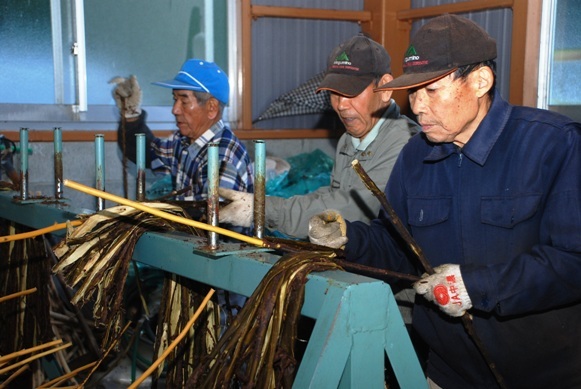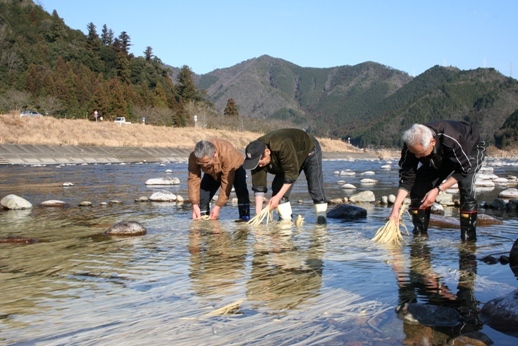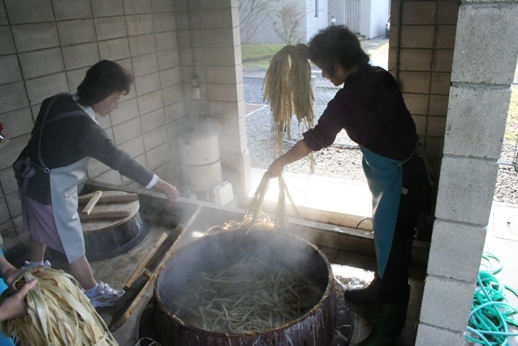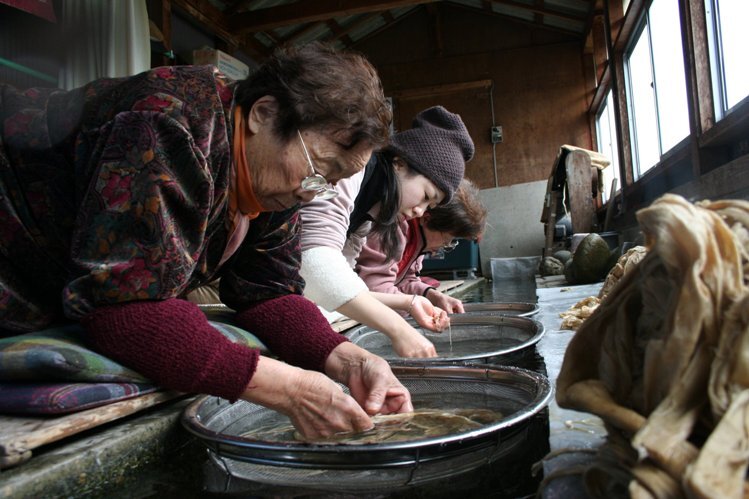原料
美濃和紙の原料には、楮、三椏、雁皮などがあります。
楮(こうぞ)・・・障子紙、便箋、封筒
三椏(みつまた)・・・お札など
雁皮(がんぴ)・・・あぶらとり紙など
剥皮(はくひ)
楮の木の皮をむいて白い皮にします。(下写真)
Materials
“Mino Washi”paper is made from the plants: Kozo, Mitsumata and Ganpi.Kozo・・・for shoji paper,letter paper, envelope
Mitsumata・・・for bill
Ganpi・・・for blotting paper, stencil paper
Bark:Strip the bark from Kozo branches and peel black skin to make it only white parts.

さらし
原料を水に浸す事によって、水に溶けやすい不純物「あく」を除き原料を柔らかくします。
昔は「川晒し」といって、川の流れに2、3日 楮を浸しておきました。
最近は作業場に作った水槽で行われることの方が多くなりました。
Soaking
The bark is submerged in water and soluble elements are washed away.
This process used to be done in the river called "Kawazarashi".
The raw material, `Kozo`, is exposed to the river for a few days.

煮熟(しゃじゅく)
楮の繊維だけを取り出すために、晒された楮を炭酸ソーダを入れた大釜で2時間ほど煮ます。
Cooking
After it is bleached, the `Kozo` is boiled in a big pot filled with a carbonate of soda solution for two hours.

ちりとり
まだ原料に残っている黒皮などのチリ、変色した部分などを、流水の中、丹念に手作業で取り除いていきます。
Squeezing
Any remaining pieces of black bark or other colored pieces are carefully removed by hand in the water current.

叩解(こうかい)
ちりを取り終わった原料を、石の板の上に置き、木槌で叩いてほぐします。途中何度か返して十分ほど叩解します。
現在では、この作業は『ビーター』という機械で行われることも多くなりました。
Beating
After the black bark and all colored impurities removed, the Kozo fibers are placed on a stone board, and repeatedly hammered and folded over.
These days this process is usually done by using a `beater machine`.

紙すき
原料と『ねべし』と呼ばれるトロロアオイの根から抽出した液を、漉舟(すきぶね)に張った水の中に入れてよく混ぜ合わせます。
次に、簀桁(すけた)という道具を使って漉舟(すきぶね)の中の液をすくい、揺ります。
Scopping
The hammered Kozo is placed in a large vat called a `Sukibune` and is mixed with water and sticky liquid called `Nebeshi` which is extracted from the root of plants called "tororoaoi".
Next, scoop the solution with the tool called"Suketa" then swing it back and forth and side to side.
The swings make fiber entangles to shape a sheet.

圧搾(あっさく)
すき上げた紙に圧力をかけて水分を搾ります。1日間、時間をかけながら徐々に強く絞っていきます。
Pressing
Water is squeezed from a pile of paper slowly by pressure. It takes a whole day to complete the draining.

乾燥
一枚ずつはがした紙を特製の刷毛を使って板に貼り付け、天日で乾かします。
今では、中にお湯を循環させる金属製乾燥機に貼り付けて乾かすこともあります。
Drying
Each sheet is peeled off from a pile, stretched out on a board by a special brush and left to dry naturally in the sunshine. These days, metallic dryers, heated by circulation of hot water, are often used to dry sheets of paper.


選別
こうして出来上がった紙は、一枚一枚丹念に手にとって検品します。紙を光に透かして、破損、傷、チリなどの不純物があるものや斑のあるものを除き、紙の厚みも考慮して丹念に選別します。
Check
Sheets are inspected carefully. They are held up to the light, and any broken or dirty sheets are removed. The thickness of the paper is also carefully checked.

裁断
選別した紙を特製の包丁で、用途に合ったサイズに裁断します。
原料から、紙になるまで、大体10日かかります。
また、原木から取れる原料の料は、約8%、紙になるのはその半分といわれるので、100キロの楮の原木から出来る美濃和紙はわずか4キログラムほどということになります。
Cutting
Sheets of paper are cut with a specially designed knife.Having been out to a specific size, sheets of paper are bundled by the hundred.

